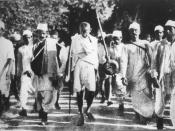According to the The American Heritage Dictionary of the English Language, Third Edition, satyagraha is "The policy of nonviolent resistance initiated in India by Mahatma Gandhi as a means of pressing for political reform." A satyagrahi is one who subscribes to satyagraha. "Holding to this truth [hate kills; love heals] in every situation, no matter how fierce the storm....he wants nothing for himself, the true satyagrahi is not afraid of entering any conflict for the sake of those around him, without hostility, without resentment, without resorting even to violent words....[satyagraha is] a complete substitute for violence" (from: Gandhi the Man: The Story of His Transformation by Eknath Easwaran, Nilgiri Press).
Gandhi appreciated the power of satyagraha and its ability to change men and the way men think. He used it to help India gain her independence from oppressive British rule. Never violent, Gandhi succeeded in forcing the most powerful empire in the world at the time to back down peacefully from a nation in abject poverty.
For instance, at the Salt Works demonstration, men stepped up fearlessly, calmly, and without anger in groups to be mercilessly beaten with iron-tipped rods. Gandhi's aim in such protests was to capture the world's attention and support by juxtaposing India's humanity to the inhumanity of the British. In doing so, people everywhere realized that India was right in fighting for her freedom.
In today's world, satyagraha could be used most effectively by people who take an anti free trade stance. Rioting and violent protests do draw attention to the cause, but the wrong sort of attention, especially now after the September 11th tragedy. Violence causes negative attitudes towards the people being violent, and their cause. Instead, those people should consider peaceful marches, lobbying, or petitions. However, perhaps the best way to...


